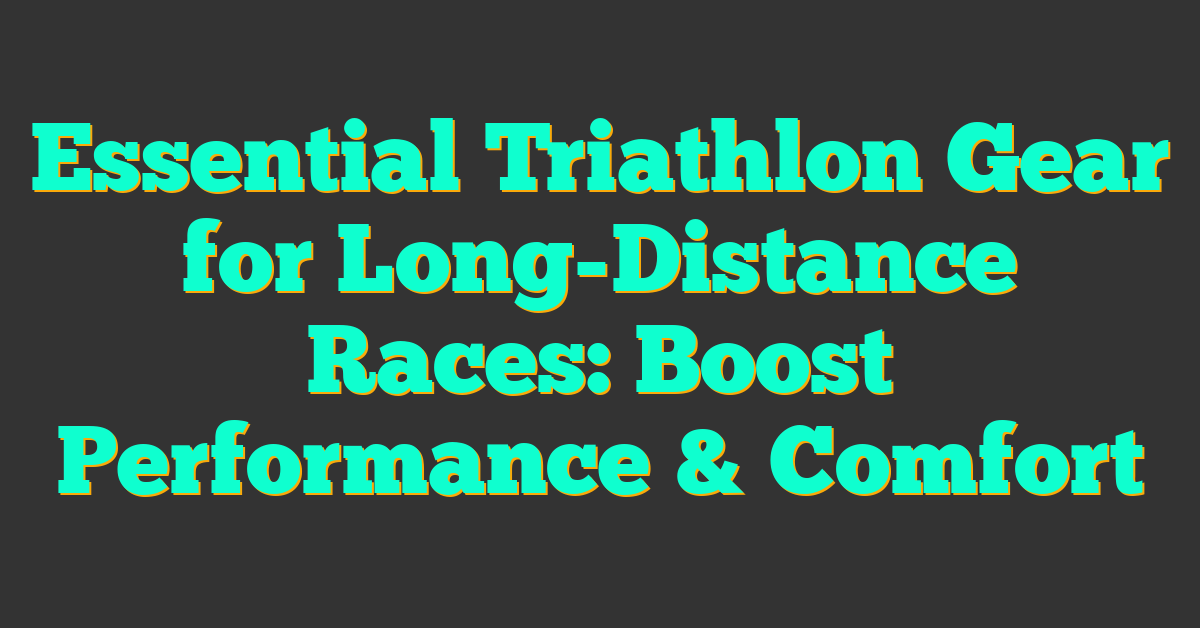Preparing for a long-distance triathlon can feel overwhelming, especially when it comes to choosing the right gear. I’ve been there, juggling countless options and wondering what will make that extra mile smoother. The right equipment not only boosts your performance but also ensures you stay comfortable throughout the grueling race.

From high-performance wetsuits to lightweight running shoes, every piece plays a crucial role in your triathlon journey. In this article, I’ll share my insights on the must-have gear that can make a significant difference in your long-distance race experience. Let’s dive into the essentials that will help you tackle each segment with confidence and ease.
Swimming Gear
Having the right swimming gear sets the foundation for a successful long-distance triathlon.
Wetsuits
Choosing a high-performance wetsuit enhances buoyancy and reduces drag. I select wetsuits made from quick-drying neoprene to maintain body temperature during the swim. Features like a snug fit and flexible panels ensure maximum mobility, allowing efficient strokes over long distances.
Goggles and Swim Caps
Goggles provide clear vision and protect eyes from water irritation. I prefer goggles with anti-fog and UV protection lenses to maintain visibility throughout the race. Swim caps streamline the head, minimize drag, and protect hair from chlorine exposure. Selecting caps made from silicone ensures durability and a comfortable fit.
Biking Equipment
Choosing the right biking gear is crucial for tackling long-distance triathlons effectively. Here’s what I consider essential for the cycling segment.
Selecting the Right Bike
I prioritize a triathlon-specific bike for its aerodynamic design and lightweight frame. Ensuring a proper fit enhances comfort and efficiency during the race. Key factors include:
- Frame Geometry: Optimizes riding position to reduce wind resistance.
- Material: Carbon fiber offers a lightweight option, while aluminum provides durability.
- Components: High-quality drivetrains and brakes ensure reliable performance over long distances.
- Aerobars: Essential for maintaining an aerodynamic posture and conserving energy.
Essential Cycling Accessories
Having the right accessories can make a significant difference in performance and comfort. I always equip my bike with the following:
- Helmet: A lightweight, well-ventilated helmet with aerodynamic features.
- Cycling Shoes: Clip-in shoes improve pedaling efficiency and reduce fatigue.
- Gloves: Padded gloves enhance grip and protect my hands on long rides.
- Cycling Computer: Tracks speed, distance, and cadence for optimal pacing.
- Lights: Front and rear lights ensure visibility during early morning or evening races.
- Water Bottles and Cages: Convenient hydration is vital, so I use easy-access bottles mounted on the bike.
Having these key components ensures I’m well-prepared and can focus on performing my best during the biking leg of a long-distance triathlon.
Running Essentials
Equipping myself with the right running gear enhances my performance during long-distance triathlons. Here are the key essentials I rely on:
Best Running Shoes
Selecting the best running shoes boosts my endurance and reduces injury risk. I choose lightweight models with ample cushioning from brands like Nike, Asics, and Saucony, which offer shoes designed for endurance racing. Proper fit ensures comfort over extended distances and prevents blisters, allowing me to maintain a steady pace throughout the race.
Compression and Support Gear
Compression gear improves my blood flow and minimizes muscle fatigue. I wear compression socks and sleeves from brands like 2XU and CEP to support my legs and enhance recovery. Additionally, athletic braces provide extra stability during intense segments, helping me maintain optimal performance and reduce the risk of strains.
Nutrition and Hydration
Proper nutrition and hydration are crucial for maintaining energy and performance during long-distance triathlons.
Hydration Systems
Choosing the right hydration system ensures you stay hydrated throughout the race. I prefer using:
- Handheld Bottles: Typically hold 500ml, easy to carry during the run.
- Hydration Packs: Offer 1-2 liters storage, suitable for longer distances.
- Bike-Mounted Cages: Allow quick access to fluids while cycling, usually accommodating two 500ml bottles.
Each system provides convenient access to fluids, helping me maintain optimal hydration levels during each race segment.
Energy Supplements
Energy supplements keep my energy levels steady during the race. I rely on:
| Supplement Type | Example Brands | Benefits |
|---|---|---|
| Energy Gels | GU, Clif Shot | Quick carbohydrate boost |
| Energy Chews | Honey Stinger, PowerBar | Easily digestible carbs |
| Electrolyte Tablets | Nuun, SaltStick | Replace essential salts and minerals |
Using a combination of these supplements helps me sustain energy, prevent fatigue, and maintain electrolyte balance throughout the triathlon.
Technology and Gadgets
Technology enhances every aspect of long-distance triathlon racing, providing essential data and support.
GPS Watches
GPS watches track pace, distance, and route across all race segments. I rely on features like:
- Real-Time Metrics: Monitors speed, elevation, and splits.
- Multi-Sport Modes: Switches seamlessly between swim, bike, and run.
- Long Battery Life: Lasts up to 20 hours to cover the entire race.
- Connectivity: Syncs with smartphones for detailed data analysis.
« How to Train for Triathlon with a Foam Roller: Boost Flexibility & Recovery
The Role of Volunteers in Triathlon Events: Ensuring Success and Support »
Models like the Garmin Forerunner 945 and Suunto 9 offer accuracy and durability, ensuring reliable performance during intense races.
Heart Rate Monitors
Heart rate monitors provide crucial insights into my cardiovascular performance. Key benefits include:
- Precision: Uses chest straps or optical sensors for accurate readings.
- Comfort: Lightweight designs prevent distraction and ensure ease of movement.
- Data Integration: Connects with GPS watches and cycling computers for comprehensive tracking.
- Extended Battery Life: Supports long races without needing frequent recharges.
Top choices like the Polar H10 and Garmin HRM-Pro deliver consistent and precise heart rate data, helping me manage effort and maintain optimal performance throughout the race.
Conclusion
Preparing for a long-distance triathlon is no small feat. Choosing the right gear made the journey smoother and more enjoyable for me. Each piece of equipment played a role in boosting my confidence and performance.
Remember the right gear can make all the difference. Trust your choices and gear up to conquer your race with confidence. Here’s to smashing your goals and enjoying every mile of the triathlon experience!










